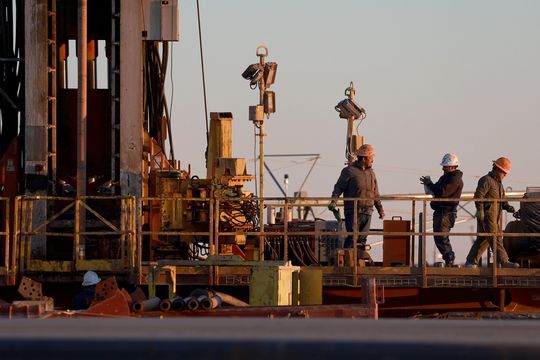Natural-gas futures trade more than 8% lower for the week
Oil futures rose on Friday, eying their first gain in three sessions, after major producers raised output as expected and outages in Libya fed concerns about reduced supply.
What’s happening
Front-month August West Texas Intermediate crude CLQ22, 1.78% CL.1, 1.78% rose $1.65, or 1.6%, to $107.41 a barrel on the New York Mercantile Exchange. Prices traded down about 0.2% for the week, FactSet data show. They ended Thursday with a gain of 5.5% for the second quarter and a loss of 7.8% for the month of June.
Read: Energy leads commodities surge with oil up roughly 50% in first half of 2022
September Brent crude BRNU22, 1.60% BRN00, 1.60%, the global crude benchmark, rose $1.52, or 1.4%, to $110.55 a barrel on the ICE Futures Europe, with the contract trading up by more than 1% from the week-ago settlement. It rose 6.4% for the quarter, but fell 6.5% in June.
August natural gas NGQ22, 5.73% NG00, 5.77% climbed 32.6 cents, or 6%, to $5.75 per million British thermal units, after plunging nearly 17% on Thursday. It trades more than 8% lower for the week.
Among the petroleum products, August gasoline RBQ22, 2.65% added 2.3% to $3.6181 a gallon and August heating oil HOQ22, 2.99% traded at $3.9715 a gallon, up 3.7%.
What’s driving markets
Oil prices have come off multi-year highs in recent weeks — with Brent retreating from more than $140 a barrel touched in March — amid concerns that slowing economic growth may crimp demand.
However, lingering worries about tight supply, and signs activity in China is picking up, continue to support energy prices.
On Thursday, the Organization of the Petroleum Exporting Countries and its allies confirmed a proposal to boost output by another 648,000 barrels a day in August.
However, the “question on future output levels was left unanswered and this could add to the overall uncertainty,” said Lukman Otunuga, manager, market analysis, at FXTM.
The West would like to see more supply in order to curtail inflation and reduce reliance on Russian production following the country’s invasion of Ukraine. With that in mind, traders will be keeping a keen eye on whether U.S President Joe Biden can convince Middle East producers to increase supply further when he visits the region in mid-July.
“With so much going on, July could be a volatile month for the global commodity.”
— Lukman Otunuga, FXTM
“With so much going on, July could be a volatile month for the global commodity,” Lukman told MarketWatch.
Adding to fear about inadequate output was news that Libya’s National Oil Company had declared force majeure on Thursday as the country’s political crisis deepens. Daily exports have fallen to about a third of production seen in “normal circumstances,” NOC said.
“The market is stuck in the push-pull between the current deteriorating macro backdrop and the looming threat of a recession, pitted against the strongest fundamental oil market setup in decades, maybe ever,” said Michael Tran, commodity strategist at RBC Capital Markets, in a recent note to clients.
In addition, strikes next week on Norwegian oil platforms may cut 4% of the country’s production, according to Reuters.
There was better news for U.S. households on Thursday, when natural-gas prices slumped to a three-month low after the extended shutdown of a large liquified natural-gas plant in Texas helped utilities to boost their stockpiles. Natural-gas futures are well off the 14-year high near $9.50 per mBtu touched less than a month ago.
The natural-gas market “got blindsided” after the Energy Information Administration on Thursday reported a bigger-than-expected weekly rise in supplies, said Phil Flynn, senior market analyst at The Price Futures Group. “That’s raising concerns that the Freeport LNG terminal [outage] is having a bigger impact on supplies and previously thought.”

